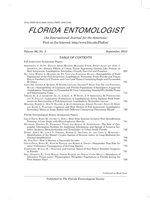Chitinase activity was measured from nonmolting workers of a subterranean termite, Reticulitermes virginicus Banks. The specific activity of cellulase was 6-fold greater than that of chitinase. An ability of R. virginicus to digest chitin would allow utilization of additional food resources that contain dietary nitrogen lacking in wood.
Subterranean termites (family Rhinotermitidae) of the southeastern United States ingest chitin, which if digestible would provide the insect with dietary nitrogen (Waller & LaFage 1987). Gut chitinase has been detected qualitatively in a few termite species (Noirot & Noirot-Timothee 1969; Mishra & Sen-Sarma 1981) but not in others (Mishra & Sen-Sarma 1981). The current study aimed to identify whether chitinase is present in nonmolting workers of a subterranean termite, Reticulitermes virginicus Banks, and subsequently to determine the specific activity of chitinase along with that of cellulase for comparison.
Wood infested with R. virginicus was collected in Oktibbeha County, Mississippi. Workers selected for assay were similarly large in size and had darkened abdomens. This appearance indicated molting was not occurring, as termites appear milky white during a molt (Laine & Wright 2003). Therefore, measurable chitinase activity would likely be from enzymes in the digestive tract. Assay procedures are described in Arquette (2011). Chitinase was determined to be present in crude extracts, and subsequently assays for pH optima and specific activity of chitinase as well as cellulase were carried out. Cellulase specific activity was about 6-fold higher than that of chitinase (Fig. 1).
Invertebrates produce many billions of tons of chitin annually (Tasch 1973). It is the most abundant polysaccharide in the insect body (Kramer & Muthukrishnan 2009) and is also synthesized by fungi. Termites ingest chitin from various sources, including fungi in decayed wood, and other termites via cannibalism and necrophagy (Moore 1969). They may also consume disintegrated cuticle along with rotting wood, as cuticle of dead arthropods is brittle and breaks apart easily (Tasch 1973). Chitinase is present in the digestive tract of insects with a chitinous diet (Fukamizo et al. 1985), with increased activity at the time chitinous foods are eaten (Merzendorfer & Zimoch 2003).
For the current study, high cellulase specific activity compared with that of chitinase could be anticipated, because wood cellulose is the major food of R. virginicus. However measurable chitinase activity showed that additional food resources besides wood are available, which provide all components necessary for the insect to live, i.e., carbohydrate for glycolysis and fat production, and nitrogen for protein synthesis. Some areas for future study include determination of sites where termite gut chitinase is synthesized, and whether chitinase activity varies between species of Rhinotermitidae as well as between colonies of the same species.
Fig. 1.
Cellulase and chitinase specific activity from 3 groups of 50 Reticulitermes virginicus workers + SEM. Specific activity is defined as the amount of enzyme at pH 5.0 that released one nmol reducing sugar as glucose (celluase assay) or N-acetylglucosamine (chitinase assay) per min per mg protein.

ACKNOWLEDGMENTS
We thank Nathan Little, Mississippi State University, for assistance in collecting and processing termites for this study. This manuscript was approved for publication as Journal Article No. 12245 of the Mississippi Agricultural and Forestry Experiment Station, Mississippi State University.





